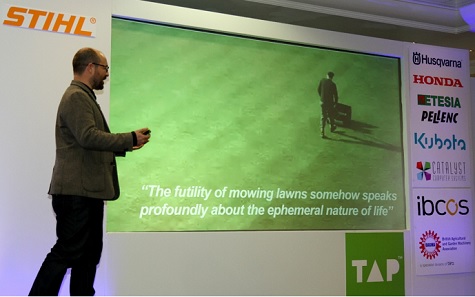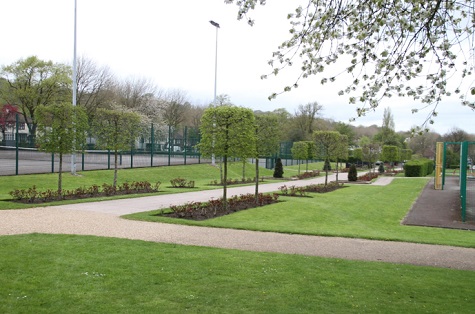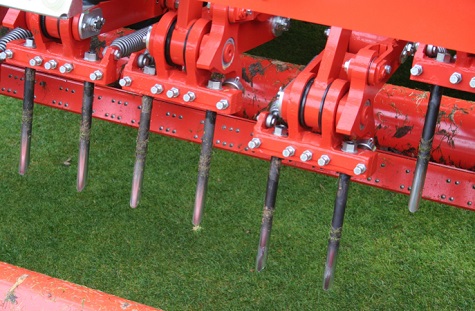Firstly today, I’d like to take the opportunity to thank a number of my work colleagues for their effort in ensuring the success of this year’s Service Dealer Conference & Awards held on November 15th at the Oxford Belfry Hotel.
I personally enjoyed meeting so many industry professionals and having the chance to talk in depth about some of the challenges facing our industry in the coming years.
Service Dealer owner, Duncan Murray-Clarke, hosted the day and began by acknowledging the fact that this past season had been quite a trying one for many outdoor powered machinery dealers. However, said Duncan, "We have a room full of talented dealers here and we're here to look ahead to what the next 30 years might throw at us and how we are going to not just cope, but thrive in the world of groundcare and agriculture."
I have personally seen for myself how much our industry has changed in the last thirty years, particularly in terms of increased efficiencies and the wider choice of machinery, equipment, products and services we now have available. Who knows what the next thirty years will bring?
Attention of the Conference quickly turned to what may lie ahead in the coming years for the specialist dealer network and our industry in general, with a fascinating presentation from futurist Ed Gillespie. As well as being a futurist, Ed is also a writer, serial entrepreneur plus a board director of a farm, located underground in disused London tube station.

Ed Gillespie
Ed spoke of how the future won't simply be an extension of today - but rather in considering what the future might be, we should be stretching the idea of what we may consider impossible. Ed said that that changes in the future will see some jobs destroyed, but many new ones created. The farming industry for example, said Ed, will focus on small, autonomous robots rather than large tractors. He also believed that our transactional system of purchasing equipment outright, would move more into a system of sharing services.
Ed also spoke of how the concept of increased urbanisation in the future shouldn't necessarily be thought of as a bad thing. With innovations like vertical farming, green roofs and 'hairy buildings', cities could well feature more green spaces than ever before.
Which brings me onto the matter of the value of green space. Last year, parks and green spaces minister, Marcus Jones, launched a new Parks Action Group to help England’s public parks and green spaces meet the needs of communities now and in the future.
Parks are an essential part of the fabric of all our communities. Whether for health and wellbeing, exercise, relaxation, places to volunteer and socialise, for children to play, encountering nature, adapting to climate change or just providing a place to gather your thoughts. Let alone all the environmental and biodiversity benefits.

With national research showing that parks and green spaces are the most used local public facilities with over 37 million visits annually, and a growing problem of obesity and inactivity in young people, they have never been more important to the future of our nation.
However, as we all know, for many years, local authorities have been reducing budgets through successive financial challenges. Some parks budgets have now been cut by 100% with other authorities now proposing to sell off parks.
Where once our Victorian ancestors led the world in public parks for public benefit we now enviously look on as other countries invest and maintain parks to a much higher degree as they place parks at the centre of the long-term health, wellbeing and community cohesion strategies.
The need for quality parks and green spaces has never been greater; and neither has the communities’ expectations and desire to see their local green space maintained and improved.
I personally believe, that we as an industry should find ways to support this new Parks Action Group to help safeguard the future of our green open spaces and land assets.
Many of our large organisations and manufacturers should by default ensure we are seen to be backing this initiative and helping drive the message home of the value of these assets.
We should also participate in many annual fundraising events to raise the profile and at the same time raise funds. Why not start our ow industry campaign (Green Nose Day?) which could help raise awareness of the value of green spaces and at the same time raise money which we can use to safeguard the future of these assets.
All of the existing recognised organisations, such as the RHS, Fields in Trust, University and colleges APSE, IOG, BIGGA, BALI, English Heritage, National Trust, Green Flag, and many more could all support this new initiative which would in turn help galvanise our industry and help stimulate the future protection of these valuable parks and open spaces.
Turning attention to the weather, for most groundsmen and greenkeepers the next few months will be the most challenging, with air and soil temperatures dropping - added with the threat of freezing conditions and plenty of rain.

In my role as pitch advisor for the RFU, I am constantly seeing the damage done by the lack of essential aeration work being carried out on club pitches. This has the net result of pitches becoming unplayable, losing grass cover and becoming compacted.
Once a pitch becomes saturated, meaning all the pore (air) spaces in the soil profile remain filled with water, then we are in a situation of the pitch being in a poor state and thus it will be prone to damage.
It is important to understand what soil type you have on your pitch, as the ability of the pitch to drain freely and how long it takes for floodwater or surface water to disperse from your pitch, will be dictated by the type of soil you have.
However, the main contributing factor that reduces and damages pore spaces in soil is compaction caused by compression forces, normally associated with play and use of machinery - particularly during wet weather periods.
Playing on saturated pitches will bring disastrous results. It is often better to postpone a fixture rather than ruin the playing surface for the rest of the season. Scrummage and line-out play are the main causes of damage on rugby pitches during wet weather periods. The severity of the damage will be dependent upon the soil type and the ability of the top 100mm to drain quickly.
To help alleviate compaction problems a programme of aeration is necessary. There are a wide range of professional aerators for use on winter turf pitches, available as walk-behind, ride-on, trailed or tractor mounted units.

Depending on the condition of the soil you should be aerating on a monthly basis, trying to aerate to a depth of between 100-200mm.
Once a year you should aim to aerate to a greater depth (200-300mm) using a larger, more powerful aerator. This will help dramatically, especially if you can topdress the pitch immediately afterwards with sand, enabling this material to go down into the aeration holes.